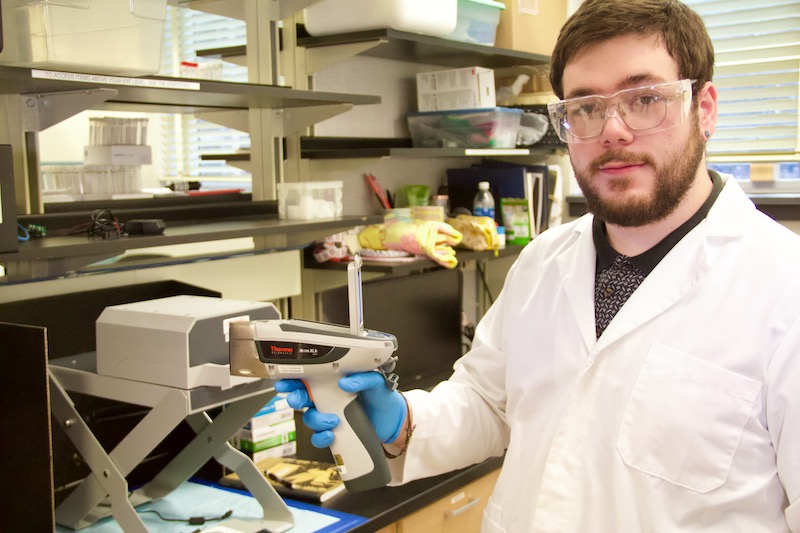X-ray fluorescence assists Purdue Health Sciences undergraduates with exposure science, environmental health and toxicology research

Health Sciences senior Anthony Bovenschen shows the portable “gun” piece of X-ray fluorescence machinery in the lab of Jae Park, Health Sciences associate professor.Tim Brouk
Anthony Bovenschen, a senior in the Purdue University School of Health Sciences, might have made the cast of “Vanderpump Rules” rethink their drinking habits had the results of his research study been different.
In fall 2023, the young researcher in associate professor Jae Hong Park’s lab investigated eight different bottles of various wines for traces of heavy metals — elements such as lead, arsenic and chromium that are harmful to human health. The work relied heavily on X-ray fluorescence (XRF), which uses X-ray technology to measure amounts of toxic metals in objects such as glass, cork and wine.
Bovenshcen did not find anything harmful within the wine or cork, but he did gain more research and lab experience. While medical school is the Honors College student’s goal after graduation, the four years he spent in Park’s lab have been formative and valuable for him as a future medical professional.
“I enjoy it so much, and I just know how important this could be as a stepping stone for students who want to go on to graduate or professional school or are trying to get a job straight out of college,” Bovenschen said. “This is a great thing to put on your resume.”
Acquired through a grant from the Provost Office’s instructional equipment program, this field-portable XRF machine represents a collaborative asset among Purdue Health Sciences faculty, serving both teaching and research purposes. While multiple faculty have XRFs in their labs, this field-portable machine stands out for its user-friendly interface, making it intuitive for Health Sciences undergraduate researchers from various labs to operate. Featuring a portable, handheld XRF “gun” for fieldwork, it is capable of conversion to a benchtop unit and can be seamlessly connected to a computer. This machine proves to be as versatile as it is invaluable for identifying substances hazardous to human health.
Scanning for elemental ‘fingerprints’
The field-portable XRF equipment comes with presets tailored for specific sample types. During Bovenschen’s experiments in the fall, there was no preset specifically for wine, so the researcher utilized the “soil” preset instead. The machine conducted thorough analyses down to the atomic level, distinguishing between various elements and searching for potentially toxic heavy metals. The researcher sifts through the data, seeking the presence of the target metals.
“Every element has its own fingerprint,” Bovenschen said. “When the X-rays hit these atoms, they excite them. The X-rays rebound back into the machine with different energy levels, depending on what atom it’s hitting. The XRF is able to analyze many different metals at the same time, and it tells you the concentration in parts per million.”
Bovenschen utilized the benchtop mode, wherein the handheld XRF gun is securely fixed within a test stand equipped with a tray for sample placement and a sturdy lid, ensuring user safety by shielding them from any stray X-rays. With just a few clicks on the screen, he could obtain results within minutes. This user-friendly interface makes XRF technology accessible even to novice undergraduate researchers, allowing them to gain valuable hands-on experience safely and without direct exposure to X-rays.
Back to bioaerosols
As Bovenschen prepares for his May graduation, he is finishing his Purdue undergraduate research career on a bioaerosol project in Park’s lab. Bioaerosol is an inclusive term for air particulates of biological origins, such as viruses and bacteria, that can be breathed in and cause harm to humans. But regardless of the type of project, Bovenschen gained immense experience and confidence over his four years of lab experience as he explores medical schools.
“Just being around all this research, being able to talk to others about their work, not only is it getting skills in this area of science but also people skills,” Bovenschen explained.
Park agreed. The active involvement of undergraduates in research from the outset not only enriches their experience within Purdue’s College of Health and Human Sciences but also significantly bolsters their prospects for future career paths or graduate studies.
Thanks to Park’s initiatives and the utilization of cutting-edge technology like the XRF machine, students gain invaluable hands-on experience in the lab, coupled with essential proficiency in advanced technology. This comprehensive approach equips them to undertake a wide range of Health Sciences student projects with competence and confidence.
“Once they complete all the trainings, student researchers are free to use it,” Park said. “With XRF, they can measure the metals in cells, metals in welding fumes extracted from a factory and within respiratory filters. It has so many uses — easy to use and convenient.”
Discover more from News | College of Health and Human Sciences
Subscribe to get the latest posts sent to your email.